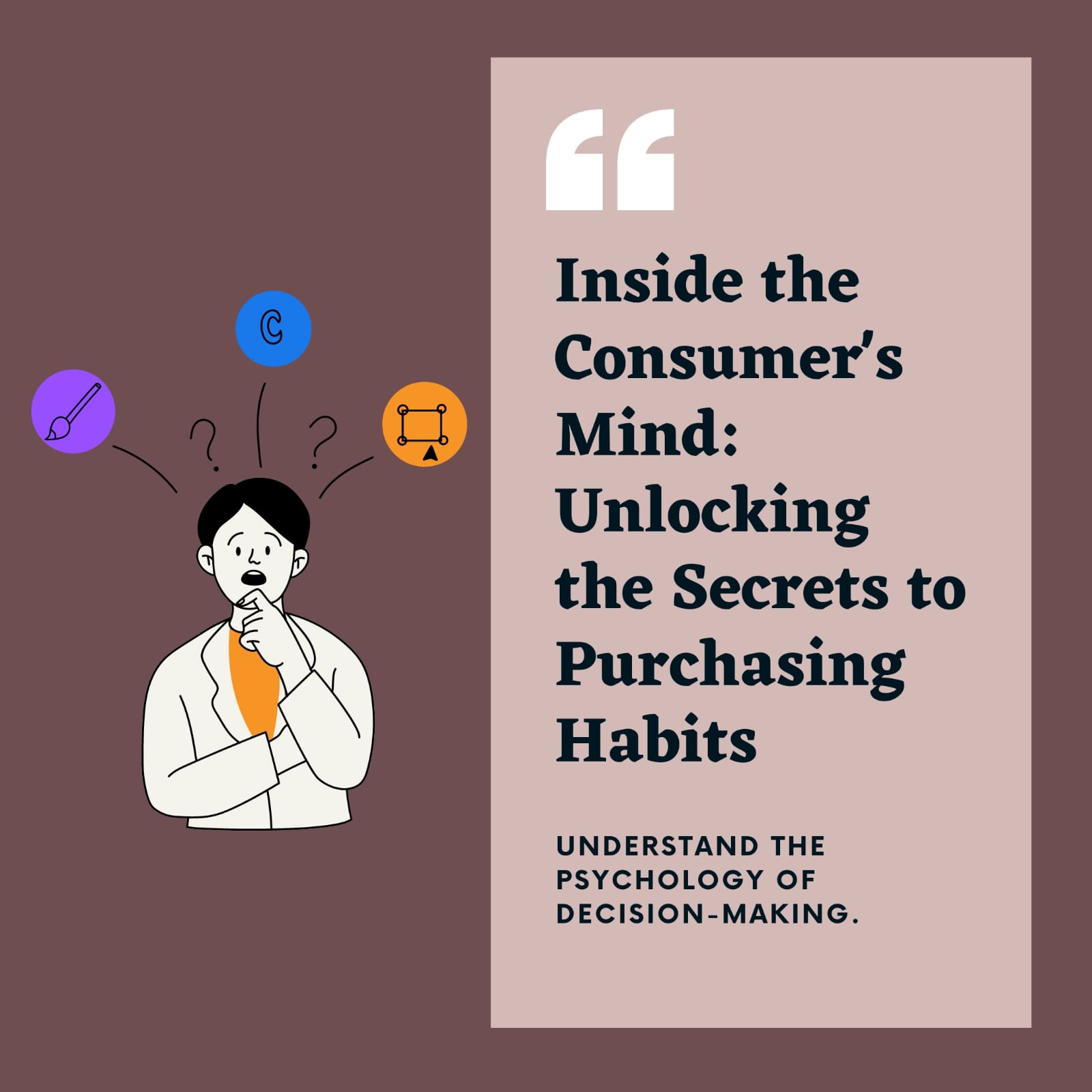
The main aim of marketing is not actually about products or services but more on what your target customers want, feel, and behave. Consumer’s Mind is extremely complex; understanding it is vital for effective marketing. On the one hand, many believe that marketing simply means the creation of attractive advertisements and striking taglines. However, nowadays the concept of marketing can be considered as a science that amalgamates psychotherapy, sociology, and statististics. This will be discussed in this paper on Psychology of marketing and how to exploit it. In this course, we will deal with such aspects as understanding consumer behavior and motives and using psychology in developing a marketing strategy. Thus, we are now going to delve into the marketing psychology.
- Introduction: Understanding the importance of consumer psychology in marketing
Knowledge about customers’ psyche is essential for every successful marketing strategy in the present-day highly-competitive environment. Over time, conventional marketing methods lose their appeal as consumers are becoming savvier. Understanding the buyer’s mentality enables you to touch people at a deeper level and drive their buying habits.
This discipline of consumer psychology focuses on understanding underlying motives, wants, and action tendencies behind consumers buying decisions. Understanding such psychological factors enables marketers to design effective engagement and persuasion strategies for consumers. Marketers can reach deeper into consumer psychology to understand the emotional and psycho-logic triggers through which a customer will be brought about making a decision, rather than just using commonplace adverts or fancy hoardings.
The main point in this regard is that of perception. Consumers’ perceptions of a brand, its products, as well as its messaging are key determinants of their attitudes and purchase intents. Marketers should create an emotional bond between consumers by crafting a brand identity that resonates with their core beliefs, aspirations and values. The connection creates trust, commitment, and positive identification that lead customers to prefer your brands rather than other competitors.
Social influence is also a critical element in consumer psychology. Being human is a social experience, where one cannot help but give credence to the advice or opinion of other people. Social Proof and Testimonials in Effecting Consumer Behaviour. The marketers’ strategy of portraying positive feedbacks and endorsement from contented consumers will provide an insight on how human beings have a sense of social approval and validity that would prompt them to choose the brands displayed.
Decision making is another aspect explored in consumer psychology. Marketers should be able to incorporate consumer psychology in order to successfully design persuasive campaigns. Marketers can guide consumers’ decisions in favour of selling products through techniques such as scarcity, urgency, and creating an anchor. Marketers can persuade consumers by showing them attractive options that promise value, exclusivity and instant satisfaction which lead to a decision of purchase.
Finally, it can be noted that consumer psychology plays an important role in successful marketing. Social influence and decision making play crucial roles in enabling marketers to come up with strategy that cuts deep into their audience’s psyche. Through addressing consumer psychology, companies are able to forge significant relationships and confidence that ultimately leads to customer loyalty and sales increases. Let us now discuss the intriguing field known as consumer psychology and uncover useful tools for marketing.
- The power of emotions in marketing: How emotions influence consumer behavior
Emotions in marketing are crucial for a successful marketing campaign. Consumers are also influenced by emotions in terms of the behavior they exhibit as well as their decision makings. In fact, logic and reason do not lead to anything but rather a direct link to feelings determining the consumer’s actions.
However, leveraging emotion successfully requires that you realize what emotions are relevant for it. Responses have to be turned with regard to definite sensations corresponding to certain emotions and envisaged outcome of a brand. In particular, there is the element of anticipation and excitement as an effective instrument to signal about the coming new product promotion within a short period. Nonetheless, memory longings and emotions are known to create durable brand recognition and build client loyalty.
Advertising has been using emotions as potent weapons in marketing, and it will continue using them. Many times, marketing campaigns provoking sensations of happiness, concern or compassion tend to stay in the minds of the customer for longer periods. Marketers employ such emotions for making memorable records that touch to the targeted audience core.
Similarly, storytelling also entangles the involved individuals emotively with the additional capacity of making the consumers to have emotions. People identify with brands that relate through storytelling. Customers also tend to be emotionally attached to certain brands, resulting in loyalty towards them.
The Role of Emotion in Successful Marketing. Consumers’ behaviour is significantly influenced by emotions in determining their choice to make. While logic and reason are important, emotion is often the driving force behind a consumer’s decision.
However it is critical to understand on what emotions to use a leverage to succeed. Every response needs to be tuned to particular emotions leading from various emotions which are in line with a brand of desired outcome. Take for instance, excitement and expectation can be a good instrument to introduce a new product ad its promotional activities for only a short duration. This means that while cherished memories may provide deep brand recognition of connecting to long term customers.
Advertisers have successfully used emotions as powerful weapons in their marketing campaigns over the last many years. Many of the adverts which evoke emotions such as happiness, fear, and empathy tend to create lasting memories among consumers. Marketers use such emotions as a means of creating enduring memories for their potential customers.
In addition, storytelling makes people feel emotion as it involves them. People want a brand that tells story, they want something they feel for and remember. Customers are also likely to stay faithful with their favored brands because of emotional attachment.
- Cognitive biases: Unraveling the subconscious factors that shape consumer decisions
Some consumer choices are also irrational and illogical. Indeed, there are several cognitive biases which have an impact on these decisions. Knowledge of such biases could offer important knowledge about the psychology of marketing, thus allowing companies to formulate better advertising plans.
An example of a cognitive bias includes anchoring effect. Such reliance is often observed whenever customers depend on the initial input encountered while making decisions. Such as, if a good had cost $100 initially, and then sold at $80, the buyers might see this sale as a reduction, but actually it had not cost that sum of money beforehand. Using this ‘price endowment’ effect, business can utilize this bias to manipulate consumer perception and construct a perception of a bargain price.
Another vital prejudice involves social proof which refers to the propensity to follow the actions and views of others. Often, customers tend to rely on the experience of others when making a choice for themselves. That’s why they have a great power of testimony, review and rating as the instruments of marketing. Businesses can leverage on the ‘social proof’ bias by demonstrating the positive feedback or reaction of pleased clients towards a product or service.
Another cognitive bias that marketers can exploit is the scarcity bias. This implies that people appreciate those things which they can feel or get least in quantity. These include limited edition products and time bound offers, which create urgency and exclusivity thereby push consumer towards faster buying decision. Businesses can build consumer appetite by craftily emphasizing scarcity in their marketing messages.
By understanding how cognitive biases impact consumer’s decisions, it becomes easier for marketers to form persuading messages and devised productive market plans. By leveraging these hidden drives, companies can establish deeper relationships with customers to enhance sales and customer loyalty.
- The psychology of persuasion: Leveraging persuasion techniques to influence consumer choices
In the world of marketing, understanding the psychology of persuasion is quite impressive. Brands can make use of persuasion tactics in order to persuade consumers to buy their products thereby driving sales.
Social proof is one very significant notion of persuasion. Individuals often rely on others to make their purchase decisions. Brands can build credibility among consumers by featuring customer reviews or even testimonials, as well as social media comments and positive mentions from satisfied customers. A feeling of confidence is created in prospects that they have chosen correctly, while social proof works as an inducement.
Scarcity is another useful strategy. There is always the feeling that one may lose out a good thing. Brands can utilize this fear by evoking a sense of urgency or limited availability in order to inspire prompt consumer actions. The feeling of urgency could be induced by offers such as limited time-offers, deals available only to certain people or when an item is in low stocks which prompt customers into making the purchase early.
Emotions are powerful tools in persuasion and they cannot be ignored. Decision making is significantly influenced by emotions and often goes beyond reason. By connecting with consumers’ emotions, brands can form a rapport with their intended target group. One way to achieve this is using stories, bringing in a relatable narrative and evoking emotion that echoes the brand’s mantra.
Furthermore, the utilization of reciprocity as a persuasive tool holds significant influence. When a brand offers value or something valuable to consumers, it generates a sense of obligation. This reciprocal relationship can effectively motivate consumers to reciprocate by making a purchase or further engaging with the brand.
By incorporating psychological techniques strategically into marketing campaigns, brands can greatly enhance their ability to influence consumer choices. This includes leveraging social proof, scarcity, emotions, and reciprocity to effectively persuade consumers and drive sales.
- Social proof and herd mentality: How social influence impacts consumer decision-making
Social Proof and Herd Mentality’s Impact on Consumer Decisions. However, as humans we often make our decisions depending on other people’s opinions and deeds. It is part and parcel of us and has been found useful for driving sales as well promoting trust and believability among consumers.
Other people’s endorsements- be it an online review, a testimonial by someone famous, or mention in social media networks – shape greatly how we perceive the product by ourselves. This is why we trust other people’s experiences and opinions with which we have something in common concerning demographic positioning as well as preferences.
Marketers can use the social proof also through showing popular trends, remarkable sale volumes or celebrities’ recommendations apart from individual testimonials. Such strategies play upon our inherent urge for social belongingness or identification with a group or a clique. Other people are embracing that brand/product and that makes us want to follow suit lest you miss out or be lagging in some way.
Social influence has been enhanced in the digital era, as one can easily share and validate through social media sites instantly. Influencer marketing is a strong weapon in modern times because an influencer is considered as someone ordinary but with large fan base. Consumer behavior is influenced by their endorsements, resulting in huge sales.
Social proof and herd mentality are two concepts that every marketer should be aware of when they design compelling adverts based on social influence. Testimonials, reviews, and endorsement form part of the strategic marketing tools a company may utilize to build trust and confidence thus expand its customers’ base.
- The role of branding and identity: Creating emotional connections and brand loyalty
The success of any brand lies largely with building emotional attachment and commitment through branding and identity. An excellent quality of goods and services is not enough in the today’s competing environment. The contemporary consumer is attracted to brands in which they believe in, that elicit positive feelings and have an identity value.
A good brand name extends far deeper than just having a creative slogan like logos and tags. This is the values, personality, and purpose of your brand’s identity. Increased loyalty and advocacy happen when consumers resonate with these elements, developing an emotional connection with your brand.
Story telling can create an emotional bond with the audience. Create interest through an engaging and unique brand story that connects with consumers and leaves a long-lasting memory. Storytelling is crucial when selling to customers. It enables them to connect with the brand at a much deeper level whether it’s pointing out the origin of your product, displaying individuals behind the brand, or simply telling customers about their experiences that could be similar to the consumer.
Another important part in creating and maintaining brand loyalty is consistency. The more that consumers see your brand across differing touch points – such as, for example, on social media, in adverts, and on packaging – the greater is their sense of confidence in what you do. It creates confidence through predictable service and enhances dependability on brands hence enabling customers prefer one brand over others.
In addition, building emotional connection is also beneficial in reinforcing brand loyalty at your fingertips. Creating a sense of belonging is important for consumers. You can achieve this by building communities around shared interests or beliefs—this way, the customers will identify with the brand and feel a strong connection. This could be realized by engaging customers on social media platforms, holding of workshops and events, as well as coming up with a rewarding loyalty program for regular customers.
Finally, branding and identity enable organizations create emotional attachment and foster brand loyalty. You can leave a long-term mark with consumers by using methods like telling your brand’s story, staying consistent, and building a community.
- Pricing psychology: The psychological tricks behind pricing strategies
There is much in a fascinating sphere of marketing which investigates how the consumer’s mind works in order to come to certain pricing decisions. Pricing has always been seen as the most fundamental tool that businesses could use in influencing consumers’ behavior and buying attitude. Knowing how a company prices a product or service may create the consumers perception to purchase that item; a company, for instance, could use psychological pricing like setting a price just near a round number or providing many price options.
Anchoring is a popular one amongst them. In this, a higher priced option is presented at the beginning which works as a reference point to subsequent options. By setting high expectation, companies can create an impression of more attractive pricing on their other products if compared to them. The approach works by exploiting our natural inclination to cling to the first piece of information we encounter during decision-making processes.
Charm Pricing- Another Technique. In this case, prices are set close to just underneath the next whole number, like at $9.99 rather than $10. Charm pricing is based on the believe that consumers consider the price a lot lower than what it actually is, thanks to left digit effect. The first fact is that our mind usually gets stuck to the first digit of figures, whereby if we see a ‘9’ against a ‘10,’ we consider it as a bargain. The use of this psychological tool creates a feeling of worthiness among customers hence encouraging them to buy.
In addition, selling products under different prices allows customers to have a choice and exert control. Business organizations often cater for different consumer packaged deals or tires, whereby they feel empowered on the options that are within their budgets or needs. This strategy also employs the idea of decoy pricing; this entails including an unattractive and yet strategically priced alternative to make the other options appear more desirable. It could direct the decisions towards the desired choice yet allowing for the feeling of control on the part of the consumer.
Using this knowledge is an essential element of modern marketing that allows businesses to take advantage of pricing psychology. The author argues that by leveraging unconscious consumers’ motives like anchoring, charm pricing, options and others, companies are able develop a price mechanism that attracts customers and sells products. Finally, understanding the psychological dimension of prices can provide entry to novel path ways to triumph over other players in the market.
- The impact of color and design: How visual cues affect consumer perception
Colour as well as design influences consumer behaviour greatly. We all know how important are those visual cues affecting our feelings and judgement. In marketing, for instance, the most effective use of colors and design elements may determine whether you catch the attention and interest of your target audience or not.
Different emotions and associations can be aroused by colours. For example, red stands for excitement, passion and emergency; and blue means trustworthiness, reliability and peace of mind. Use of these colors in branding and on marketing materials allows effective communication of the desired message to your customers.
Similarly, the design elements you use within your marketing campaigns can influence the way consumers perceive the product. A clean and minimalist approach creates a sophisticated and up-to-date air; while a more playful and lively style conveys enthusiasm and a young appeal. Designing decisions that connect on a more profound level by comprehending your target market and its preferred tastes.
We should bear in mind, however, that cultural and personal differences may not always leave color and design unaffected. Positive and attracting attributes for an individual could be negative or even offensive for another person in other cultures. This implies that you ought to carry your homework properly with a view of considering culture in developing your marketing tools.
Lastly, it is evident that color and design have a strong effect on how consumers perceive a brand. Using visual cues will help improve your marketing strategy by establishing an instant attachment between marketers and their customers. Therefore, go slow and be very cautious when selecting your colours and graphic designs for best results on influencing consumer opinion and creating a compelling connection between consumers and brand.
- The psychology of storytelling: Harnessing the power of narratives in marketing campaigns
That’s because storytelling allows marketers to communicate in a more emotional, personal manner with their audiences. Stories make us feel because we are all wired for them; hence making connections and evoking empathy in people. Narrative power is a critical success factor for marketers that should be used to leverage consumer psychology. Storytelling enables an efficient brand communication and consumer engagement.
To create a good marketing message, one should be creative in approach rather than relying on traditionally proven methods to simply tell a great story. A good story has the ability to appeal to a consumer’s sensibilities through emotions, holding and finally persuading them into buying. Stories create a sense of intimacy between the reader/viewer & the narrator. As such, audiences are easily able to identify themselves with such a story.
The use of storytelling in marketing can be embraced by developing a brand story that resonates with the consumer’s ambition, desire and/or pains. Businesses can exploit the emotions of the consumers by making the brand the hero of the story and providing a solution to their problems. The use of this approach provides a meaningful impression on buyers creating both memory for brand and trust, hence loyalty.
In addition, narrative can be integrated in many marketing platforms including social media advertisement clips, videos and websites. Companies can create a strong brand experience by telling the same story across numerous platforms, which enhances the memory of the brand on consumers’ minds.
To summarize, marketers should gain insights in the psychology of storytelling so they can communicate with the public more effectively. Business can capture consumers’ hearts by using narratives; engage the consumers; and finally succeed in building a strong brand through effective storytelling in marketing.
- Ethical considerations in consumer psychology: Balancing persuasion and responsible marketing
In the fast-paced world of marketing, it’s crucial to prioritize ethical considerations alongside our pursuit of persuading consumers to purchase our products or services. Striking a balance between using persuasive tactics and practicing responsible marketing is not only morally right but also essential for fostering long-term trust and loyalty from our customers.
Transparency is a crucial factor in ethical consumer psychology. In today’s highly informed society, consumers expect brands to be upfront and truthful about their products, pricing, and business practices. Any misleading or deceptive advertising tactics can swiftly erode consumer trust and harm a brand’s reputation. Hence, it is crucial to guarantee that all marketing communications are honest, precise, and offer customers with transparent information.
When it comes to responsible marketing, it’s important to be mindful of how our messages can affect vulnerable populations like children or individuals with limited decision-making abilities. We must avoid any aggressive or predatory marketing tactics that specifically target these groups in order to uphold ethical standards in consumer psychology.
When it comes to consumer psychology, maintaining ethical practices is crucial. Ethics in marketing require finding a balance between persuasion and responsible advertising. By prioritizing transparency, honesty, and the well-being of our customers, we can establish stronger connections with them, develop brand loyalty, and contribute to an ethical and sustainable marketing industry.
- Conclusion: Embracing consumer psychology to create effective marketing strategies
In conclusion it is crucial to have an understanding of consumer psychology and incorporate it into our marketing strategies. By gaining insights, into the thoughts, motivations and decision making processes of consumers we can create campaigns that truly resonate.
An important aspect of consumer psychology is the influence of emotions. By connecting with our target audience on a level we can craft marketing initiatives that leave a lasting impression. Whether it involves evoking nostalgia generating happiness or appealing to their desires emotions play a role in shaping consumer choices.
Additionally comprehending the concept of proof can significantly enhance our marketing endeavours. Consumers often rely on the opinions and experiences of others when making decisions. By showcasing reviews, testimonials or endorsements from customers we establish trust and credibility that encourages potential buyers to choose our products or services.
Cognitive biases also wield influence, over consumer behavior. By recognizing and effectively utilizing these biases in our strategies we can align with consumers natural thought processes. From anchoring biases to scarcity effects these cognitive shortcuts can be leveraged to create a sense of urgency that drives conversions and boosts sales.
Lastly personalization has become increasingly vital in today’s marketing landscape. Crafting messages, offers and experiences, for each customer by taking into account their preferences, demographics and previous interactions can greatly amplify engagement and foster loyalty. By comprehending the inclinations of consumers and providing encounters we can forge a connection, with our clientele ensuring their continuous return.
To sum up when we embrace consumer psychology and integrate its principles into our marketing strategies we can obtain an advantage establish a connection, with our target audience and ultimately achieve success, in our business endeavors. By comprehending the factors that impact consumer behavior we can develop marketing campaigns that’re more effective and influential resonating with our customers and motivating them to take action.
Author – Anushka Mishra











